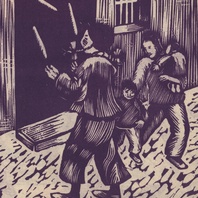
Item
Fengyang guniang (Maidens of Fengyang)
This woodcut, by an artist called Fang Wenxing, was reproduced in Zhonghua huabao (Chinese Pictorial) 1.4 (November 1943). The importance of the muke (woodcut) form to artistic practice in occupied China has been almost entirely overlooked in the literature. The muke form has hitherto been associated with the art of resistance in China, despite being an important part of “occupation” visual cultures as well.
Read More
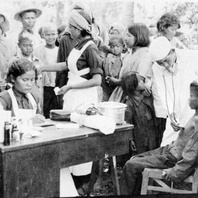
Featured Item
Medical team treating children
This unattributed photograph, showing a medical team treating children, was featured in the publication (French and English versions) entitled The People’s Republic of Kampuchea (1979). This photograph is part of the collection held by the Agence Khmère de Presse (AKP) and Cambodia’s Ministry of Information. This collection, which documents the early years of the People’s Republic of Kampuchea as photographed by the Vietnamese and a small team of Cambodian photographers, has not yet been classified or indexed.
Read More
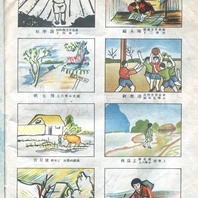
Item
Ertong zuopin (works by children), II
This is a selection of images (most being pencil drawings) contributed to the magazine Ertong huakan (Children’s Pictorial) 9.10 (April 1941) by readers. The images offer a fascinating insight into the ways in which official ideas about the appearance of occupied China were reflected in the artwork of Chinese school children living in the RNG capital. Note the references to dawn, for example, the depictions of Japanese people, and the idyllic images of the Chinese countryside included in some of the drawings. Basketball remained a politically acceptable sport in occupied Nanjing despite its American provenance.
Read More
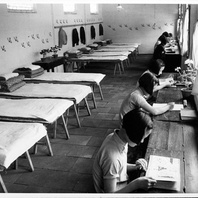
Item
Girls are all living in a dormitory [sic]
From a collection of staged photographs produced under the title “Life at a Girls School in Peking”, and produced at the Peking Jiyu Gakuen in Japanese-occupied Beijing. The original caption reads: “They are doing their ‘home works’ [sic]”.
Read More
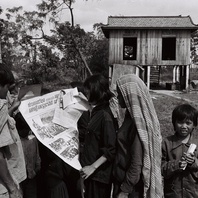
Featured Item
Village children looking at a poster
This (probably staged) photograph shows a group of village children looking at an illustrated poster celebrating the Kampuchea United Front for National Salvation (KUFNS, also known as FUNSK) [Front or Renakse]. It is part of a series that describes the same group of villagers and soldiers. This photograph is part of the collection held by the Agence Khmère de Presse (AKP) and Cambodia’s Ministry of Information. This collection, which documents the early years of the People’s Republic of Kampuchea as photographed by the Vietnamese and a small team of Cambodian photographers, has not yet been classified or indexed.
Read More
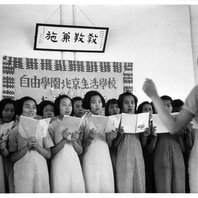
Item
A chorus group [sic]
From a collection of staged photographs produced under the title “Life at a Girls School in Peking”, and produced at the Peking Jiyu Gakuen in Japanese-occupied Beijing.
Read More
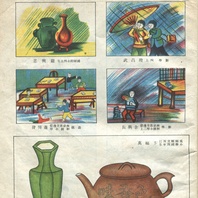
Item
Ertong zuopin (works by children), I
This is a selection of images (most being pencil drawings) contributed to the magazine Ertong huakan (Children’s Pictorial) 9.10 (April 1941) by readers. The images offer a fascinating insight into the ways in which official ideas about perceived notions of student behaviour in occupied China were reflected in the artwork of Chinese school children living in the RNG capital. Two of the drawings in this selection, for example, relate to the hardships of studying (in difficult weather, poor light, etc), while one depicts children playing in a classroom.
Read More
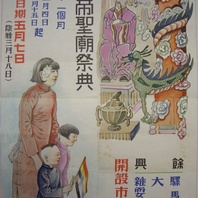
Item
Yaodi shengmiao jidian (Ceremony at the Emperor Yao Temple)
This poster was produced (almost certainly by the Japanese military) with the aim of advertising the re-opening of the Emperor Yao Temple (Yaodi shengmiao) in Linfen (Shanxi Province). This site was taken by the Japanese from communist resistance fighters, and was used by the Japanese as a symbol of the apparent iconoclasm and lack of religious sensitivity shown by the communists. The re-opening the temple to worshippers in the spring of 1938 by the Japanese was used to demonstrate the extent to which occupation supposedly included respect for Chinese religious traditions. The painted image of the female worshipper here was based on a photograph of a female worshipper at the same temple produced in other propaganda leaflets some months earlier.
Read More
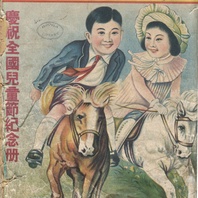
Item
Qiantu wuliang (An immeasurable future)
Cover of a magazine which was published in Nanjing for children themselves during the Japanese occupation. The artist who created this image is not named. Publication details are: Ertong huakan (Children’s Pictorial) 9.10 (April 1941): cover image
Read More
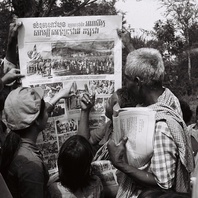
Featured Item
Villagers and soldiers pointing at poster
This (probably staged) photograph shows a group of villagers and soldiers reading an illustrated, A0-size propaganda poster celebrating the Kampuchea United Front for National Salvation (KUFNS, also known as FUNSK) [Front or Renakse]. The image provides a clear view of the poster and the photos on it. The poster’s title reads: “Fight for the Front” (or, more literally, “rush and struggle under the front’s flag”). The photos on the poster have captions in Khmer. One of the older villagers holds the upper right-hand corner of the poster. He has a folded poster in his other hand. Next to him, a young boy points his finger at the top picture, which shows the founding of the Kampuchea United Front for National Salvation in Kratie in December 1978. A female soldier points her finger at the caption below the picture. This photograph is part of the collection held by the Agence Khmère de Presse (AKP) and Cambodia’s Ministry of Information. This collection, which documents the early years of the People’s Republic of Kampuchea as photographed by the Vietnamese and a small team of Cambodian photographers, has not yet been classified or indexed.
Read More
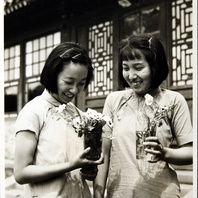
Item
Two girls picked flowers for the dinner table [sic]
From a collection of staged photographs produced under the title “Life at a Girls School in Peking”, and produced at the Peking Jiyu Gakuen in Japanese-occupied Beijing. The original caption reads: “Two girls picked flowers for the dinner table [sic]”.
Read More
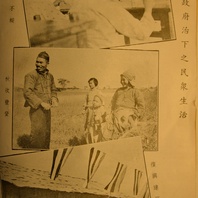
Item
Weixin zhengfu zhixia zhi minzhong shenghuo (The life of the masses under the Reformed Government)
This series of unattributed photographs is taken from the Daminhui publication Xin Zhongguo (New China) 3.1 (January 1940). They are used here to present scenes of life under the rule of the Reformed Government (Weixin zhengfu), or RGROC, which was a “client regime” established in 1938. The RGROC was eventually amalgamated with Wang Jingwei’s RNG in March 1940. The top image is entitled “xian’ge bu chuo” (“studying never stops, even in times of strife”); the middle image is entitled “qiu shou fengdeng” (gathering the autumn harvest); the image at the bottom of the page is entitled “fuxing jianzhu” (renovating buildings). All three are typical images of the sort that the Daminhui promoted in the period between 1938 and 1940, but also display a clear influence from Manchukuo propaganda photography from earlier in the 1930s.